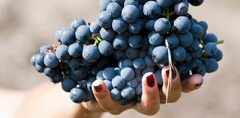|
 Petit Verdot hails from Bordeaux, where it is most often used in the region's famous red blends to add dark violet color, stouter tannins and impart concentrated fruit flavor on the palate. However, because Petit Verdot tends to ripen later in the season it carries a "hit or miss" reputation, depending on the vintage, as to whether or not the fruit will actually make it to harvest and be a viable addition to a Bordeaux blend. Petit Verdot hails from Bordeaux, where it is most often used in the region's famous red blends to add dark violet color, stouter tannins and impart concentrated fruit flavor on the palate. However, because Petit Verdot tends to ripen later in the season it carries a "hit or miss" reputation, depending on the vintage, as to whether or not the fruit will actually make it to harvest and be a viable addition to a Bordeaux blend.
The secret to growing Petit Verdot are long days and lots of sun.
 With this in mind, New World growers have given Petit Verdot a second chance to shine in regions with consistent, extended growing conditions. The results have been stunning. Case in point, not only do these warm weather regions, like Argentina, Australia, California, Chile and Washington, give Petit Verdot a chance to completely mature, they also afford it the opportunity to shine front and center. As such many producers have bottled the grape on its own, effectively forsaking the historic blend, where it only played a minor role. With this in mind, New World growers have given Petit Verdot a second chance to shine in regions with consistent, extended growing conditions. The results have been stunning. Case in point, not only do these warm weather regions, like Argentina, Australia, California, Chile and Washington, give Petit Verdot a chance to completely mature, they also afford it the opportunity to shine front and center. As such many producers have bottled the grape on its own, effectively forsaking the historic blend, where it only played a minor role.
Petit Verdot is a highly concentrated grape, exuding abundant color, structure and flavor. Classified as a red wine, the intense hues lean well into the blue-black range, often with a fuller body, higher alcohol content, and decidedly dry taste profile. With remarkable tannic structure, medium to high acids, (depending on the region) and black fruit dominating the aromatics and palate flavors, Petit Verdot can be a loud, rambunctious wine that may well be softened by age or blending.
 Due to the rigid tannin structure and concentrated nature of this wine, foods with plenty of weight, protein and fat are your best bets. Consider rich cuts of red meat, well-aged cheese (like Stilton) or wild game. Barbecue, beef stew, roasted rack of lamb and game birds all stand up well to the rich appeal of Petit Verdot. Due to the rigid tannin structure and concentrated nature of this wine, foods with plenty of weight, protein and fat are your best bets. Consider rich cuts of red meat, well-aged cheese (like Stilton) or wild game. Barbecue, beef stew, roasted rack of lamb and game birds all stand up well to the rich appeal of Petit Verdot.
.
|